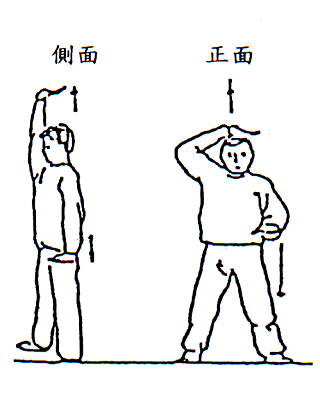(通左右八十個穴位)
這是一項極簡單的運動方式,但功效則不簡單。
- 預備式:雙腳微開,身體直立,挺直脊骨,左手五指伸直,反掌貼在頭頂正中的地方,左手掌心向天,掌背貼在頭頂的「百會穴」上,右手同時五指伸直手踭向後微曲,將挺指的掌放在左腰部上位,掌心向地,掌背向上。
- 叫「一」,同時左掌用力向天直伸,放在腰部的右掌一齊應聲用力向下登直,成為一隻掌向天直伸,一隻掌向地直伸,伸直後隨即恢復原狀,即左掌仍然掌心向天、掌背貼位頭頂,右掌仍然掌心向地貼近左腰。隨即叫「二」,再做上述動作十次。
- 右掌放在頭上,左掌放在腰間,動作和1、2相同,只是換了右掌伸直向天,左掌伸直向地,亦做十次。
這一式是左右掌分別各做向天向地伸直的動作,是符合現代伸展運動理論的健身鍛煉,又和中國經穴的理論相配合。何琼師傅在演式時說:這一式通兩邊身血管及左右八十個穴位。我們知道,頭頂上正中的穴位叫「百會穴」,左右膊有肩井穴,手踭上有曲池穴,大姆指與食指之間有合谷穴,此外左右耳穴位頗多,其中腎盂穴等,都因左右掌向上下用力登直而得到震動,使各穴的經脈能流通,因此對腦、心、腎、肩、臂、指和中樞神經都產生療效。這就是有病治病,無病強身的原因。

Posture 10: Hand Exercise
The tenth posture of Luk Tung Kuen is known as “Hand Exercise”. Let us first analyse the posture and then its name.
Starting position: Stand Upright. Raise up the right arm. The right hand should touch the top of the head at the position of Bai Hui acupuncture point (百會穴) with the palm facing upward. Keep the fingers straight. Bend the elbow of the left arm slightly and the hand should be at the level of the waist with the palm facing downward.
Movement 1: When ready, the instructor count “one” push the right hand upward with effort. Meanwhile, the left hand pushes downward with effort, fingers pointing forward. That is, one hand pushes upward and the other hand pushes downward. Bring the right arm down to the original position, that is, the right hand still touches the top of the head and the left hand is still at the level of the waist. When count “two”, repeat the movement. Repeat the movement for ten times.
Movement 2: Reverse the position of the right arm and the left arm with the left hand touch the top of the head and right hand at the level of the waist. The movement is the same as mentioned in movement 1. The only difference is that it is the turn for the right hand to push upward and the left hand downward.
From this posture, we can see it is a stretching exercise for the right arm and the left arm and the exercise is designed in accordance with the theory of our modern times. This matches the theory of acupuncture at the same time. According to the explanation of Ha Kinh, this posture can facilitate the free circulation of blood and the eighteen acupoints. It is understood that on the top central part of our head there is the Bai Hui acupoint (百會穴); both the left and right shoulder has Jian Jing acupoint (肩井穴); the Qu Chi acupoint (曲池穴) can be found on the elbow; while in between the thumb and the first finger there is the He Gu acupoint (合谷穴). Besides, there are many acupoints found near the ears such as Shen Yu acupoint (腎盂穴). The stretching of both arms stimulates these acupoints which in turn stimulates the function of the brain, the heart, the kidney, the shoulder, the arms the fingers and the central nervous system. This exercise can cure one who is sick and strengthen one’s well-being.
